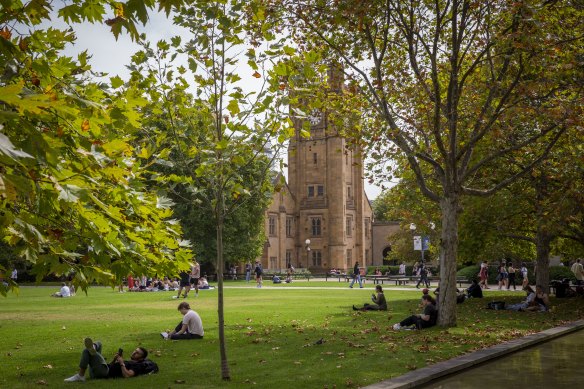Save articles for later
Add articles to your saved list and come back to them any time.
Key points
- The University of Melbourne has been ranked 14th on the QS World University Rankings.
- QS ranked the University of Sydney and the University of New South Wales equal 19th in the world.
- The Australian National University lost its top spot among Australian universities on the QS rankings.
- Professor Duncan Maskell says the results show that Australian universities are among the best in the world.
The University of Melbourne has achieved the highest-ever global ranking of an Australian tertiary institution in the annual QS rankings, as three Australian universities claim a spot among the world’s top 20 for the first time.
The rise comes after a change in the ranking formula that added factors like sustainability and employment outcomes, and de-emphasised academic reputation and the teacher-student ratio.
The University of Melbourne is Australia’s top institution in the QS World University Rankings.Credit: Wayne Taylor
The 2024 QS World University Rankings show a continued rise for the University of Melbourne – last year the only Australian institution in the world’s top 50 – to move up the rankings. This year, the university climbed another 19 places, from 33rd to 14th.
The University of Sydney and the University of New South Wales also entered the top 20, tying in 19th place.
QS Quacquarelli Symonds, a global higher education analyst that has ranked the world’s universities annually for the past 20 years, this year changed the methodology of its rankings to introduce sustainability, employment outcomes and international research networks into its assessment.
But it gave less weight to indicators such as academic reputation and the faculty-student ratio, which assesses teaching resources. Australian institutions recorded their lowest average score in the faculty-student category, with 29 of its 38 universities sliding.
QS research director Ben Sowter said Australia performed well in measures including citations per faculty, employment outcomes and under the new sustainability indicator.
“Reducing the weight on faculty-student ratio has enabled Australia’s strength in other indicators to shine through a bit more strongly,” Sowter said. “However, the introduction of new measures that favour Australian universities is likely only going to happen once.”
All of Victoria’s major universities moved higher in the annual global rankings.
Monash University rose from 57th to 42nd, while RMIT moved from 190 to 140. Deakin rose from 266 to 233. La Trobe was once again the state’s biggest improver, up 74 spots to 242 from 316 in 2023. Swinburne University of Technology moved from 296 to 285.
The Australian National University in Canberra lost its top spot among Australian tertiary institutions, slipping from 30th last year to equal 34th.
Angel Calderon, RMIT University’s principal adviser in institutional research and a QS board member, said Australian universities performed well for academic reputation but their scores for employer reputation and faculty-student ratio were a concern.
All but one of the Group of Eight universities showed a drop in employer reputation, while only two institutions showed improvement in the faculty-student ratio.
Australia achieves the highest average scores for international faculty and international student ratio, which QS said reflected its status as a top study destination.
Data from Austrade shows Australian institutions enrolled 619,370 foreign students in 2022. This was up 8 per cent over 2021 but still down 18 per cent compared to 2019, before the pandemic.
Indian students now account for more commencements than Chinese students, while the sector’s recovery is being driven by students from Thailand, Nepal, Colombia, Pakistan and other emerging markets.
QS chief executive Jessica Turner said the Australian higher education system had consistently prioritised and pioneered internationalism.
“Despite the challenges posed by the pandemic, Australian institutions are making a remarkable comeback, attracting more students from emerging markets,” she said.
The “big four” study destinations of Australia, Canada, the UK and US claim 178 universities out of the top 500 included in the QS World University Rankings.
Among these, Australia achieves the highest average overall rankings score of 40.7, the highest score for academic reputation (31.3) and the highest score for citations per faculty (59.7).
“This score, adjusted for the size of the institution, signifies not only the quantity but also the widespread global impact and acknowledgment of their research, underlining Australia’s universities as producers of substantial and influential academic work,” QS said.
The University of Melbourne is now the highest-ranked Australian university across the three major global rankings: QS, Times Higher Education and the Academic Ranking of World Universities.
Melbourne’s Vice-Chancellor, Professor Duncan Maskell, said it was satisfying that the university had performed very well in QS’ new categories.
“These new categories represent things that are important to students when they make decisions about where to study, so I’m very pleased that QS has rated the University of Melbourne so highly.”
Maskell said the rankings reaffirmed that Australian universities were among the best in the world.
“It is an unprecedented level of recognition that underlines the significant contribution that universities make to the nation’s global reputation,” he said.
The Massachusetts Institute of Technology held its reign at the top of the QS rankings for the 12th consecutive year. The University of Cambridge held second place, while the University of Oxford took third.
The QS rankings rate 1500 universities, based on analysis of more than 17.5 million academic papers and insights from more than 240,000 academics and employers.
Get the day’s breaking news, entertainment ideas and a long read to enjoy. Sign up to receive our Evening Edition newsletter here.
Most Viewed in National
From our partners
Source: Read Full Article

